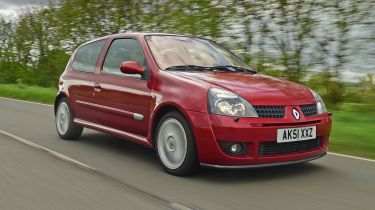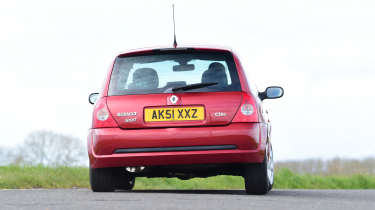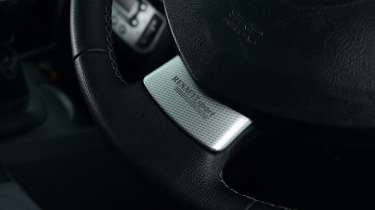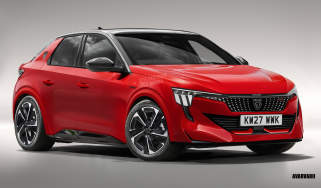Renault Clio 172 (1999-2004) icon review: a classic accessible hot hatch
We rediscover the classic French hot hatch that still thrills today
There are two things that the French unquestionably do better than anyone else: desserts and hot hatchbacks. But while we’d quite happily spend our working hours thoroughly road testing various mille-feuille and tarte tatin, this isn’t quite the forum to do so. Instead, we’ll focus on the Gallic knack for ballistic small cars.
Fast Fords and Type R Hondas of the past and present have had many moments of magic, while the Volkswagen Golf GTI is an icon of the breed. But none of those brands has so consistently competed with the way that Citroen, Peugeot and Renault mixed a magic formula of simplicity, low weight and big power to treat performance car buyers to so many thrills over the past four decades.
Of those three names, we’d argue the case for Renault to have been the most prolific over that time. From the 5 GT Turbo to the various insane Megane RS Trophy-R models, punctuated with underrated gems such as the 19 16v and the RenaultSport Twingo 133, the brand’s history has had barely a break between one superb example to the next going all the way back to the eighties.
A series of three numbers will prick the ears of any hot-hatch fans of the early noughties, though: 172. This model, and the mildly updated 182 that replaced it, followed on from the stunning Clio Williams, which were very significant (if small) shoes to fill.
More reviews
Car group tests
- Toyota Yaris vs Renault Clio 2024 twin test: hybrid supermini battle
- Renault Clio vs Skoda Fabia vs Honda Jazz group test review: a battle for supermini supremacy
- Skoda Fabia vs Renault Clio vs Vauxhall Corsa-e: 2022 group test review
In-depth reviews
Long-term tests
Road tests
- New Renault Clio 2023 facelift review: stylish French supermini gets a striking new look
- New Renault Clio TCe 90 2022 review
Used car tests
The 172 made its debut in 1999, quickly topping the range of the second-generation Clio. The classic hot hatchback ‘big engine, small car’ formula was applied, and as with the Williams, it featured a 2.0-litre naturally aspirated four-cylinder engine. Its use of variable valve timing resulted in strong low-down tractability with a little more shove towards the red line, which produced 170bhp (that’s 172 metric horsepower, hence the name) and 200Nm of torque. In a car that officially tipped the scales at a mere 1,035kg, it gave the Clio a power-to-weight ratio that doesn’t fall far short of those of more modern hot hatchbacks available today.
From the outside, the upgrades were subtle. Indeed, thanks to the hidden tailpipe, the only rearward clues as to the 172’s performance potential were a body-coloured bumper and small ‘Sport’ lettering. The front was toughened up more, though, with a deep bumper, projector-style headlights and widened arches to accommodate the 172’s wider track that came with its firmer suspension set-up. Its look was completed by 15-inch alloy wheels from OZ.
The car we’re driving today is the Phase 2, which was introduced in 2001, bringing the sharper looks of the facelifted Clio family, a new dashboard layout and climate control in place of the older car’s manual air-conditioning. Official power output remained the same, although the F4R engine gained a revised intake system and exhaust ports, and wheel size increased to 16 inches.
Compared with so many models on the road now, driving the 172 today feels like a breath of fresh air. At a time when modern performance cars are packed with technology – often implemented to compensate for ever increasing kerbweights, thus compounding a vicious circle of mass – you can hop into the 172, turn the key and just point it at your favourite bit of twisty road.
And there the Clio really comes alive. It simply feels so light on its feet; the front end is very pointy, darting from one corner to the next and capable of direction changes that more modern, heavier hot hatch machinery simply can’t live with. Despite this sharpness, the rear axle can keep up with the front, too. Only if you really provoke it with an abrupt mid-corner lift of the throttle will you require some corrective lock, but for the most part it’s just wonderfully adjustable, without feeling intimidating. You become so dialled in to the chassis that steering inputs become almost instinctive.
The powerplant is a suitably feisty foil to the brilliant handling. It hasn’t got quite the same drama as the K20 unit from the 172’s Honda Civic Type R contemporary, but the Renault’s angry engine note gains aggression as the cam fully comes on song around 5,000rpm right the way through to the red line. It’s a motor that loves to be worked hard. As with many Renaults of this age, the clutch pedal is heavy, but with a firm prod it’ll still deliver rapid shifts through the five-speed gearbox.
When Auto Express got its hands on a pre-facelift 172 back in Issue 639, the car emerged victorious in a twin test against a SEAT Ibiza Cupra. Its sense of fun won the contest, and we fell for “the Clio’s frenetic driving style and sheer mechanical exuberance” which “only serve to increase the sense of drama”. It wasn’t slow, either. Timing gear strapped to our test car back in 2001 showed that the 172 covered the 0-60mph sprint in 6.5 seconds.
There are certainly ways that the standard model can be improved, which we both noted then and agree with now. While the part-leather seats look great and offer decent support, they’re mounted too high, and a smaller-diameter steering wheel would improve the driving position even more. Those things soon fall into the back of your mind, however, because you’ll once again be revelling in that fabulous chassis in no time.
Later on, even more focused 172s were to come. They started with the Cup, which gained firmer suspension and weight-reducing measures. These included ditching the air-con and fitting the lighter rear seat bench from a base-model Clio.
The range was updated to the 182 in 2004, where further revisions to the intake and exhaust liberated the extra 10bhp that gave it its new name. It was this car from which the Trophy was born; its crowning glory was its remote-reservoir dampers developed by Sachs. The extra sophistication these brought, along with some even more body-hugging Recaro seats and a unique Capsicum Red exterior paintjob, made this limited-run model the sharpest version of one of the true hot-hatch greats.
Sadly, the likes of the 172 are unlikely to be seen again soon, with performance models from the Renault group now living under the Alpine brand rather than RenaultSport. Alpine will soon be releasing its take on a modern hot hatchback, in the form of the A290. Delivering an entertaining all-electric performance car has proven too much for many brands so far – but not impossible. If the A290 can replicate even a hint of the 172’s magic, we’re going to be in for a treat.
Interested in buying one?
Usable, high-mileage 172s cost from £2,500, while condition and miles affect value more than whether you’re after a pre- or post-facelift 172 or 182. Desirable Cups command a slight premium, and the ultra-rare Trophy is £10,000-plus. If the cambelt and dephaser pulley have been replaced on schedule and the car serviced regularly, the engine is strong. Rust is less of an issue than on BMWs, Mercedes and Fords of the era, but look inside the fuel-filler door for early rot.
The 172 seen here belongs to our chief reviewer Alex Ingram. A big hot-hatch fan, he’s owned a 205 GTi among others, but he reckons this might be the best car yet. “The Peugeot offered a bit more drama and sweaty-palmed excitement,” admits Alex, “but the 172 runs it very close. Its power steering makes it easier to push on a twisty road. The air-con is a bonus, too.”
Alex has owned the Renault since May 2023, and he was relieved to find that underneath tacky exterior decals it was a solid example. Its 70,000-mile reading is relatively low and, stickers removed, it is very original. An exception is the stainless-steel exhaust, which is a common 172 upgrade; the standard back box is heavy and this, combined with weak mountings, can cause failure.
| Model: | RenaultSport Clio 172 |
| Production dates: | 1999-2004 |
| Price then: | From £15,995 (2001) |
| Price now: | From £2,500 |
| Engine: | 2.0-litre 4cyl petrol |
| Power/torque: | 170bhp/200Nm |
| Transmission: | Five-speed manual, front-wheel drive |
| 0-62mph: | 7.2 seconds |
| Top speed: | 138mph |











